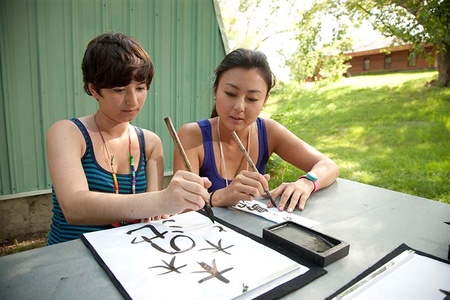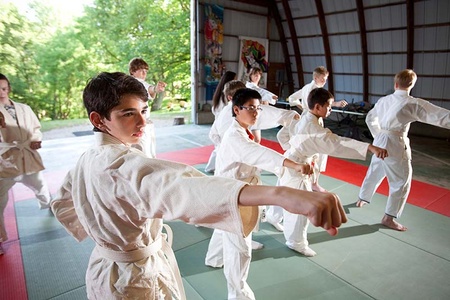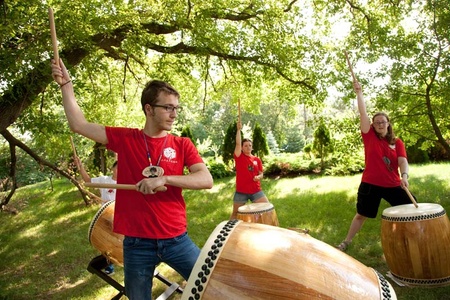In the Northern woods of Minnesota the call of a loon echoes on the lake. The wind rustles through a forest of birch trees. And at a summer camp in the dining hall, an enthusiastic group of kids call out “itadakimasu,” before digging into dinner. The sign on the building says shokudo in English, hiragana, and kanji.

Counselor and camper practicing shodo Japanese calligraphy. (Photo courtesy of Concordia Language Villages)
Mori no Ike is the Japanese language and culture immersion summer program of the Concordia Language Villages. From the moment that the campers arrive at Mori no Ike they are spoken to in Japanese. They select a Japanese name and write it on their nafuda. For the whole time they are at camp they will only be addressed by their nihongo no namae.
Throughout the day the campers break out into different groups depending on their preferred activities or language proficiency. Activities include taiko, shodo, karate, and much more. But three times a day the whole camp convenes in the shokudo. Each meal starts with a song: “Gohanda gohanda, ureshii na. Nandemo tabemasu, yoku kande. Minna sorotte, itadakimasu.”
Many of the campers don’t have the opportunity to study Japanese in their local schools so this is a special time for them. For most of the kids, this is the chance to eat Japanese food three times a day. When I was the dean of Mori no Ike, to make an easy transition to eating Japanese food, we served kara-age (Japanese fried chicken) the first night. Vegetables like broccoli or green beans dressed with toasted and crushed sesame seeds, sugar, and shoyu also doesn’t taste too foreign. Salads are dressed with a sesame wafu dressing, an easy way to get their daily fill of vegetables.
But for some, especially the younger kids, the challenge is getting the food to their mouths as there are no forks and spoons, only chopsticks. If the students are hungry and want seconds they have to ask for it in Japanese, “kara-age o kudasai”. Sensei (bi-lingual counselors) at each table will role model for them.
There are many challenges to making authentic Japanese cuisine in the woods of Northern Minnesota. Miles from a mall or even a supermarket, the cooks work hard to create delicious and nutritional food. Most meals include gohan and miso shiru. Some days there may be seafood, usually salmon or shrimp. But meat is the king in the Midwest and thus dishes like chicken teriyaki, pork shougayaki, or tonkatsu rule the menu. Even the canteen has Pocky and osembei. But before that a visit to the ginkou to get some yen is required, as the store only takes Japanese currency. And all transactions, asking for money from their bank account to purchasing snacks, take place in nihongo.
After about three days everyone has mastered using chopsticks and kids confidently ask for food to be passed to them in Japanese. Many will enthusiastically say “oishii”. And of course, each meal ends with a grateful “gochisou sama deshita”.
The kids leave with a rich understanding of a new language, culture, and the food of Japan. Strong friendships are forged. The mission of the Concordia Language Villages is, “to prepare young people for responsible citizenship in our global community”, and I believe that is achieved at Mori no Ike. Many of the campers have gone on to study Japanese at university and now some are living in Japan, and married to Japanese. I’ve spoken with some who have the opportunity to use their skills at work. At Mori no Ike we nourish the children, with food and all things Japanese.
© 2012 Yukari Sakamoto





